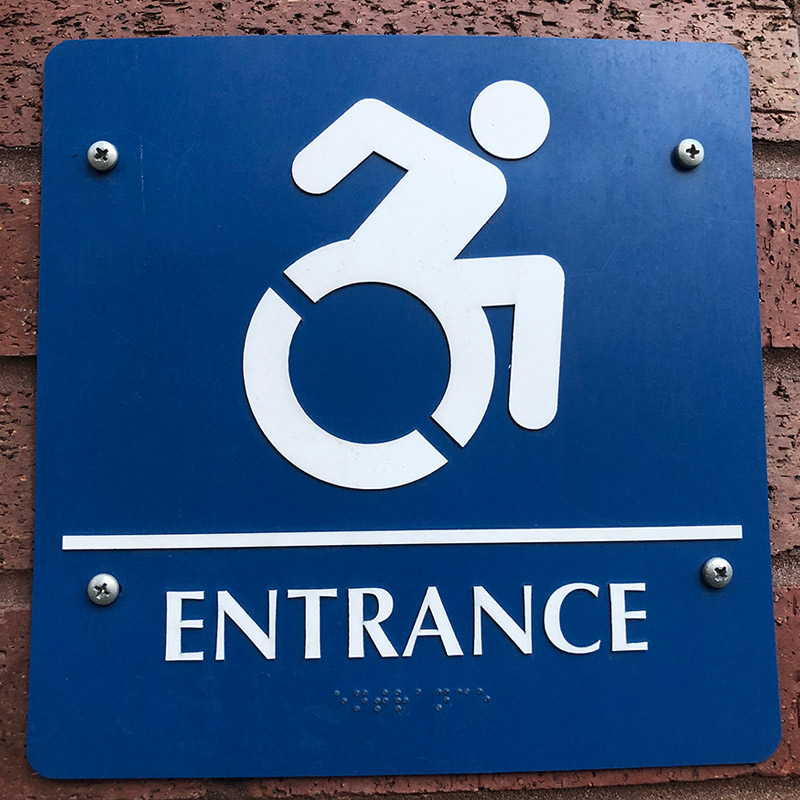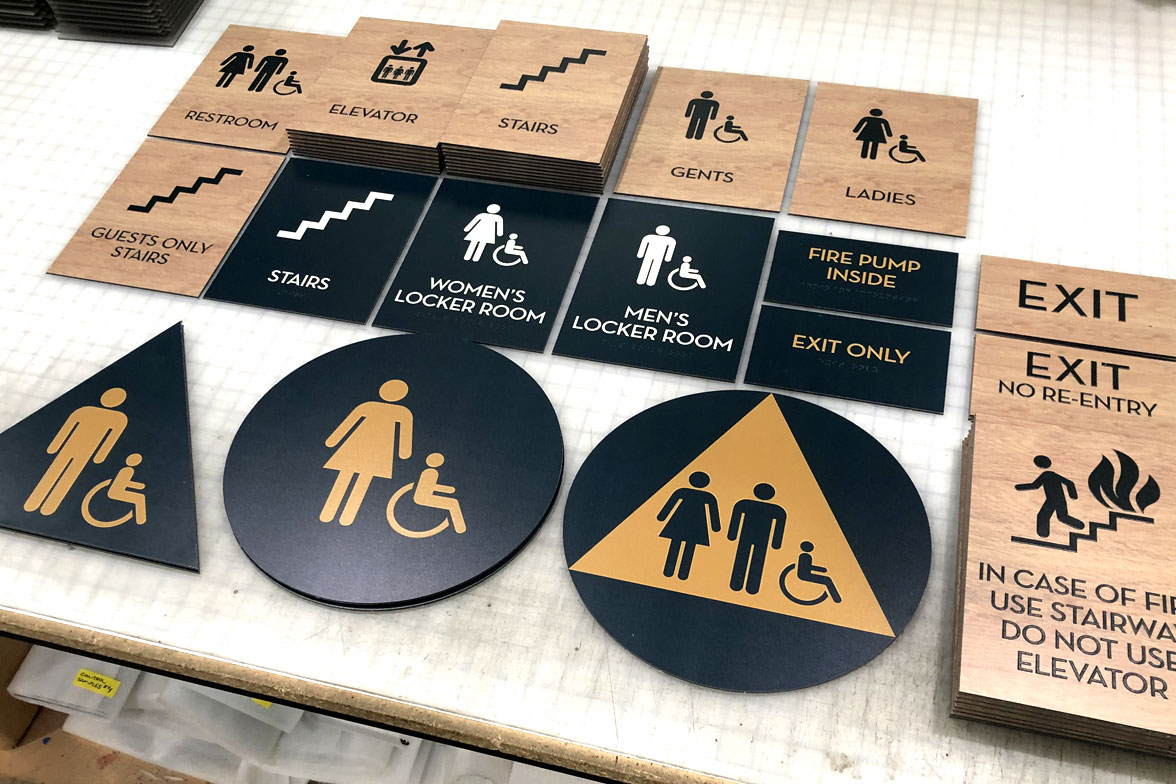The Benefits of Using Premium ADA Signs in Your Business
The Benefits of Using Premium ADA Signs in Your Business
Blog Article
Checking Out the Trick Features of ADA Signs for Improved Availability
In the realm of ease of access, ADA signs function as quiet yet effective allies, guaranteeing that areas are accessible and comprehensive for people with impairments. By integrating Braille and responsive elements, these signs break barriers for the aesthetically damaged, while high-contrast color pattern and readable font styles accommodate varied visual needs. Their strategic placement is not approximate but instead a computed effort to facilitate seamless navigation. Yet, past these functions exists a much deeper narrative concerning the development of inclusivity and the recurring commitment to producing equitable spaces. What a lot more could these indicators symbolize in our pursuit of global accessibility?
Significance of ADA Compliance
Making certain compliance with the Americans with Disabilities Act (ADA) is critical for fostering inclusivity and equal gain access to in public rooms and work environments. The ADA, established in 1990, mandates that all public facilities, companies, and transportation services accommodate individuals with impairments, ensuring they appreciate the exact same rights and chances as others. Compliance with ADA requirements not only meets lawful commitments however likewise boosts an organization's reputation by demonstrating its commitment to diversity and inclusivity.
One of the key facets of ADA compliance is the implementation of accessible signs. ADA indications are made to ensure that individuals with disabilities can easily browse with buildings and areas.
In addition, adhering to ADA regulations can mitigate the threat of potential penalties and lawful repercussions. Organizations that stop working to conform with ADA guidelines may deal with suits or fines, which can be both destructive and economically challenging to their public photo. Hence, ADA conformity is important to cultivating a fair atmosphere for everybody.
Braille and Tactile Aspects
The unification of Braille and tactile elements right into ADA signage embodies the principles of ease of access and inclusivity. It is commonly put below the equivalent message on signage to guarantee that individuals can access the information without aesthetic support.
Tactile components extend past Braille and consist of increased characters and icons. These parts are created to be noticeable by touch, permitting individuals to recognize space numbers, restrooms, exits, and other important locations. The ADA establishes certain guidelines relating to the dimension, spacing, and placement of these tactile components to maximize readability and make sure consistency throughout different environments.

High-Contrast Shade Schemes
High-contrast color pattern play a critical function in improving the exposure and readability of ADA signs for people with visual impairments. These plans are important as they maximize the distinction in light reflectance between text and history, making certain that indicators are quickly noticeable, even from a distance. The Americans with Disabilities Act (ADA) mandates the use of details color contrasts to suit those with minimal vision, making it a critical facet of conformity.
The effectiveness of high-contrast colors lies in their capacity to stick out in numerous lights problems, including dimly lit environments and locations with glare. Generally, dark message on a light background or light message on a dark background is utilized to achieve optimal contrast. For example, black message on a white or yellow history supplies a plain visual difference that aids in quick recognition and understanding.

Legible Fonts and Text Size
When taking into consideration the design of ADA signage, the option of clear typefaces and suitable message size can not be overstated. The Americans with Disabilities Act (ADA) mandates that typefaces have to be not italic and sans-serif, oblique, script, highly ornamental, or of uncommon type.
The size of the message also plays a crucial role in accessibility. According to ADA standards, the minimal text elevation ought to be 5/8 inch, and it needs to increase proportionally with seeing range. This is especially essential in public spaces where signage demands to be reviewed rapidly and precisely. Consistency in text dimension contributes to a natural aesthetic experience, helping people in navigating settings successfully.
In addition, spacing between lines and letters is integral to readability. Adequate spacing prevents personalities from showing up crowded, boosting readability. By adhering to these criteria, developers can dramatically improve ease of access, guaranteeing that signs offers its designated function for all people, despite their aesthetic capabilities.
Reliable Positioning Strategies
Strategic placement of ADA signage is important for maximizing availability and ensuring conformity with lawful criteria. Properly positioned indicators lead people with impairments properly, assisting in navigating in public areas. Trick considerations include height, presence, and distance. ADA standards stipulate that indications should be installed at an elevation in between 48 to 60 inches from the ground to guarantee they are within the line of sight for both standing and seated people. This conventional height range is critical for inclusivity, making it possible for wheelchair users and individuals of varying heights to accessibility information easily.
Additionally, indicators must be positioned beside the latch side of doors to permit very easy identification before entrance. This positioning aids individuals find areas and rooms without obstruction. In instances where there is no door, indicators ought to be situated on the closest nearby wall. Home Page Uniformity in indicator positioning throughout a facility boosts predictability, lowering confusion and boosting general user experience.

Verdict
ADA signs play an essential role in promoting access by incorporating features that resolve the needs of individuals with impairments. Incorporating Braille and tactile aspects guarantees essential information is obtainable to the aesthetically impaired, while high-contrast shade plans and understandable sans-serif font styles improve visibility throughout numerous lighting problems. Effective placement strategies, such as appropriate installing heights and tactical areas, additionally promote navigating. These components jointly cultivate an inclusive environment, emphasizing the significance of ADA conformity in ensuring equal access for all.
In the realm of availability, ADA signs serve as quiet yet effective allies, official site ensuring that areas are accessible and inclusive for people with impairments. The ADA, passed in 1990, mandates that all public centers, companies, and transport solutions accommodate people with specials needs, guaranteeing they take pleasure in the very same legal rights and chances as others. ADA Signs. ADA indications are designed to make certain that people with impairments can conveniently navigate through structures and areas. ADA guidelines specify that signs ought to be installed at an elevation in between 48 to 60 inches from the ground to guarantee they are within the line of view for both standing and seated people.ADA indications play an important duty in promoting accessibility by incorporating functions that deal with the needs of individuals with disabilities
Report this page